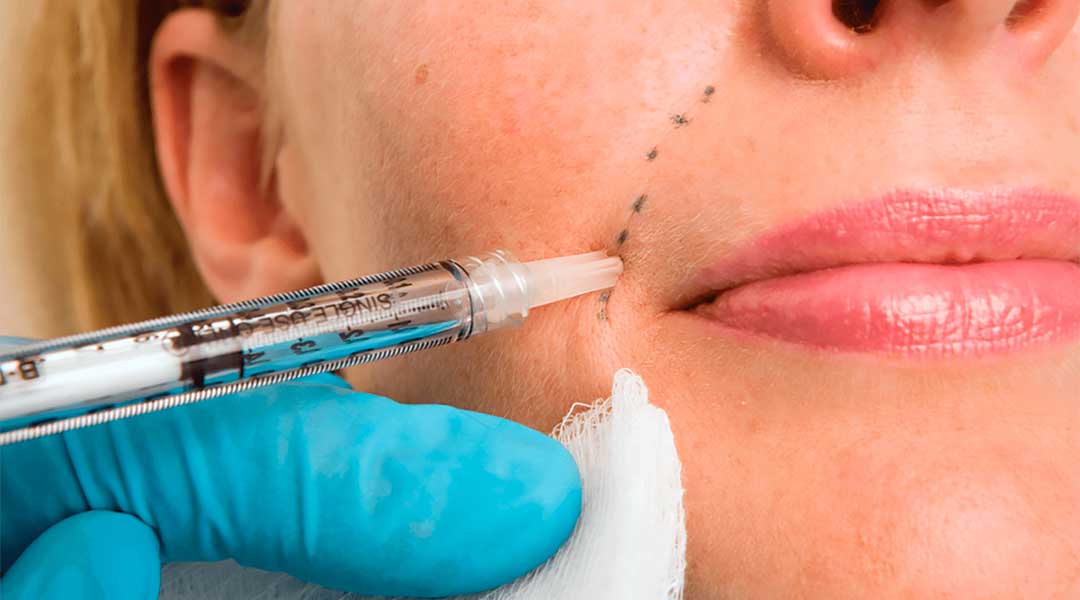Both dermal fillers and anti-wrinkle injections are forms of injectable treatment that are administered in very similar ways, but while they are both a minimally invasive injectable treatment, that’s pretty much where their similarities stop.
What are dermal fillers?
Dermal fillers are made up of a concoction of ingredients that are designed to add fullness and weight to areas that have begun to thin out as the ravages of time take their hold, or simply to add a bit of oomph to areas that were lacking. Most commonly, dermal fillers are performed in the area around the mouth such as the lips and cheeks.
When they are administered correctly, dermal fillers are able to give a wide range of results from adding a subtle smoothing effect to plumping and enhancing the appearance of your existing features, adding extra definition to your face. By using hyaluronic acid (which is a naturally occurring substance found within the skin), dermal fillers are able to;
- Add lift and volume to the cheeks and cheekbones whilst giving them a smooth and even feel
- Reshape the nose by adding plumpness to set areas, evening out the shape or removing crookedness
- Revive the appearance of the area beneath the eyes and reduce the appearance of any dark circles
- Add volume and plumpness to the lips
- Add volume to the jaw and chin, allowing for gentle reshaping and evening of the silhouette
What are anti-wrinkle injections?
Anti-wrinkle injections on the other hand are made up of a purified bacteria that is designed to inhibit the muscles that cause the face to wrinkle. By stopping the muscles from moving, anti-wrinkle injections are capable of reducing the amount of stress on the face and can help to minimize the visible signs of fine lines and wrinkles on the face, such as smokers lines and crows feet.
Even the simplest things like smiling, frowning or raising your eyebrows are partially responsible for the appearance of the signs of ageing on the face and while they are completely natural, people tend to see them as a sign that they are getting too old too quickly. Anti-wrinkle injections work as a muscle relaxant and block the impulses that are sent via the nervous system that cause the muscles to contract, effectively keeping them in a relaxed state. When the muscles are relaxed, they can’t cause the skin to wrinkle any further which (over time) results in the improvement of the appearance of any fine lines and wrinkles and can even completely remove them from a treated area in some cases.

What’s the key differences between the two?
Both can be used to fight the appearance of wrinkles, but it’s the way in which they do this which is where they are so different. To put it simply, anti-wrinkle injections effectively “freeze” the muscles to stop them from creating any more wrinkles and improve the appearance of those that are already present whereas dermal fillers are used to fill in and plump out areas that have lost their smoothness.
Another key difference is the length of time you’re likely to see results for, with anti-wrinkle injections tending to last around 4 months or so before a top up treatment is required if you want to maintain the look, whereas dermal fillers should last anywhere between 6 to 18 months before a follow up is needed (depending on the exact combination of ingredients and area that is to be treated).
One advantage that presents itself is thanks to the fact that the two treatments are so different though, and that is that due to the different substances that are used it means that you can undergo both treatments combined into one. For example, you could use anti-wrinkle injections to correct the appearance of lines and wrinkles around the eyes whilst also having a dermal filler treatment to plump out the lips and lines around the mouth.
Are there any side effects?
Like with pretty much every cosmetic procedure, both anti-wrinkle injections and dermal fillers both come with the risk of side effects that can occur, as well as some contraindications that may need to be discussed with a GP prior to undergoing treatment.
For anti-wrinkle injections, the possible side effects include;
- Bruising at the injection sites
- Eyelid drooping (which can take a few weeks to fully resolve itself)
- Redness and irritation of the eyes
- Headaches
The injections also aren’t recommended to be performed if you’re pregnant or breastfeeding, already have weakened facial muscles, are suffering from skin issues such as deep scarring or are affected by conditions such as multiple sclerosis.
When it comes to dermal fillers, the list of possible side effects include;
- Bruising and redness around the injection sites
- Potential numbness or loss of sensation
- Allergic reaction to the filler
- Infection
Temporary swelling is something that may also occur, but this can tend to be alleviated with the use of ice packs and paracetamol. The risk of these can be reduced by carrying out an allergy test before undergoing treatment. Dermal fillers aren’t recommended for smokers, and you’ll be more likely to achieve the best results if you’re generally in good health.
What’s the bottom line then?
Both are used to treat the appearance of lines and problems with the skin, but the way they get there is completely different. Dermal fillers are likely able to produce results that last longer, but they tend to carry more side effects than anti-wrinkle injections.
It’s also important to bear in mind that they are used to treat different things, so before undergoing any treatment it’s advised to discuss this and the results you want to achieve during your consultation.

